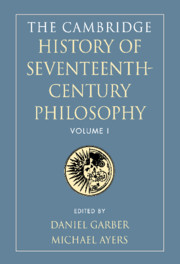Book contents
- Frontmatter
- Introduction
- I The context of seventeenth-century philosophy
- II Logic, language, and abstract objects
- III God
- IV Body and the physical world
- 15 The scholastic background
- 16 The occultist tradition and its critics
- 17 Doctrines of explanation in late scholasticism and in the mechanical philosophy
- 18 New doctrines of body and its powers, place, and space
- 19 Knowledge of the existence of body
- 20 New doctrines of motion
- 21 Laws of nature
- 22 The mathematical realm of nature
- V Spirit
- Bibliographical appendix
- Bibliography
- References
18 - New doctrines of body and its powers, place, and space
from IV - Body and the physical world
Published online by Cambridge University Press: 28 March 2008
- Frontmatter
- Introduction
- I The context of seventeenth-century philosophy
- II Logic, language, and abstract objects
- III God
- IV Body and the physical world
- 15 The scholastic background
- 16 The occultist tradition and its critics
- 17 Doctrines of explanation in late scholasticism and in the mechanical philosophy
- 18 New doctrines of body and its powers, place, and space
- 19 Knowledge of the existence of body
- 20 New doctrines of motion
- 21 Laws of nature
- 22 The mathematical realm of nature
- V Spirit
- Bibliographical appendix
- Bibliography
- References
Summary
Philosophy at the beginning of the seventeenth century was in many ways continuous with the philosophy of the sixteenth century. Aristotle and Aristotelianism continued to be taught in the schools, and thrived there. Furthermore, Renaissance naturalism, Neoplatonic thought, and the occult tradition continued to exert influence (see Chapters 15 and 16). However, quite striking in the late years of the sixteenth century and the first years of the seventeenth is a new interest in another non-Aristotelian tradition, that of atomism, and, more generally, in what were later to be called mechanist views of the world. Mechanists tended to see the world as a great machine, on an analogy with a clock, for example, and tried to explain the manifest properties of things in terms of the size, shape, and motion of the insensible particles that were taken to compose them. With those new natural philosophies came new conceptions of body and the contents of the physical world. Although the so-called new philosophers agreed that the form and matter of their teachers must go, they disagreed about what these were to be replaced by, what the physical world was to contain, what the nature of body was, whether bodies were active or passive, the nature of the place or space in which they are found, among many other questions. The views of the new philosophers can best be understood by examining first their view of the physical world in the early part of the century; second the view of the physical world held by three of the important mechanist system-builders in mid-century, Gassendi, Descartes, and Hobbes; and third later views on body and the physical world, including reactions to earlier mechanist conceptions of body, and attempts to escape the bounds of the new mechanist orthodoxy.
Information
- Type
- Chapter
- Information
- The Cambridge History of Seventeenth-Century Philosophy , pp. 553 - 623Publisher: Cambridge University PressPrint publication year: 2000
References
Accessibility standard: Unknown
Why this information is here
This section outlines the accessibility features of this content - including support for screen readers, full keyboard navigation and high-contrast display options. This may not be relevant for you.Accessibility Information
- 7
- Cited by
